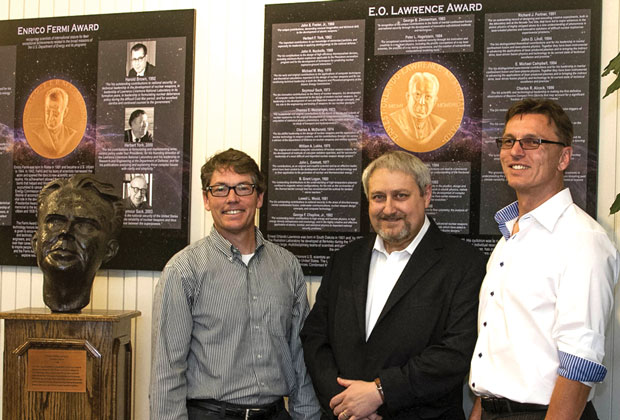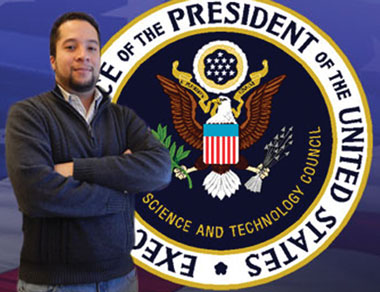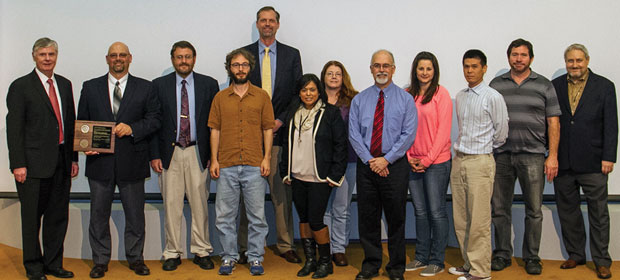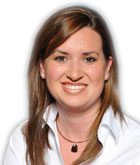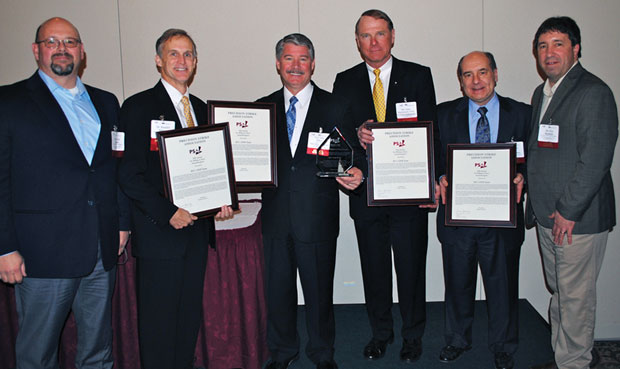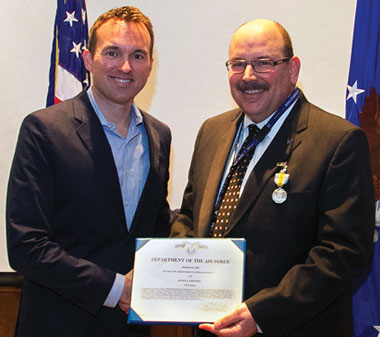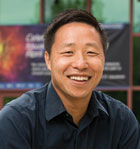The challenges of LLNL’s mission require a workforce of exceptionally talented and dedicated employees. The many awards and honors received by Laboratory personnel are testament to their expertise and the impact of their work.
E. O. Lawrence Awards
Two Lawrence Livermore researchers were recipients of the 2013 E. O. Lawrence Award, which recognizes mid-career U.S. scientists and engineers for exceptional contributions in support of DOE and its mission to advance the national, economic, and energy security of the United States. Stephen C. Myers was recognized for his work developing seismic monitoring technologies to locate nuclear explosions. Former LLNL scientist Siegfried H. Glenzer was recognized for his work on NIF, including full-scale inertial-confinement fusion hohlraum experiments.
Contributing to the Nobel Peace Prize
The Laboratory’s Forensic Science Center is one of only two U.S. laboratories accredited to conduct chemical weapons-related testing for the Organisation for the Prohibition of Chemical Weapons, which received the 2013 Nobel Peace Prize for its efforts to eliminate chemical weapons. Livermore performs testing to detect, in samples, traces of the dangerous agents and their precursors—the chemicals used to make the weapons.
PECASE Award
Miguel Morales-Silva was selected by the White House for one of the Presidential Early Career Awards for Scientists and Engineers (PECASE) for 2014. Morales-Silva was recognized for his research on first-principles descriptions of materials at high pressure and temperature using density functional theory and quantum Monte Carlo techniques. The PECASE awards are the highest honor bestowed by the U.S. government on science and engineering professionals in the early stages of independent research careers.
Office of Science Early Career Awards
Todd Gamblin and Jennifer Pett-Ridge were selected by DOE’s Office of Science for Early Career Research Program Awards. Gamblin was selected for his work to accelerate the adaptation of scientific simulation codes to increasingly powerful supercomputers. Pett-Ridge was selected for her study of microbes that drive carbon transformation in tropical soils.
Defense Programs Awards of Excellence
Eleven teams of Laboratory scientists and engineers received an NNSA Defense Programs Award of Excellence in recognition of work performed in 2013 supporting Defense Programs missions. The teams were presented with their awards by NNSA Deputy Administrator for Defense Programs Don Cook.
NIH Director’s Early Independence Award
Livermore computational scientist Amanda Randles received a Director’s Early Independence Award from the National Institutes of Health (NIH) to help develop tools to predict where in the human body cancer is likely to metastasize. The NIH award provides funding to encourage exceptional young scientists to pursue high-risk, high-reward research in biomedical and behavioral science.
The William J. Perry Award
The team that developed the BLU-129/B low-collateral-damage weapon, which includes contributors from LLNL, received the 18th annual William J. Perry Award in recognition of “the immediate and long-term impact the BLU-129/B has had and will have on combat operations.” The award “also honors the impressive public and private sector partnership that led to this technological advance.”
Air Force Awards for Meritorious Civilian Service
Scott Couture and Steven DeTeresa received U.S. Air Force Awards for Meritorious Civilian Service. Couture was recognized for his work as the Air Force Under Secretary’s principal adviser for nuclear matters. DeTeresa helped the Air Force forge agreements with the U.S. Navy and the United Kingdom’s military establishment.
Young Achievers Award from IEEE
Abhinav Bhatele received the 2014 Young Achievers Award from the Technical Committee on Scalable Computing of the Institute of Electrical and Electronics Engineers. The award acknowledges early-career individuals who have made outstanding, potentially long-lasting contributions in the field of scalable computing. Bhatele’s work focuses on optimizing communications on different supercomputers—often a major bottleneck to scalability.
Society Fellows
Seven Laboratory researchers were made fellows of professional societies. Ken Moody became a fellow of the American Association for the Advancement of Science. Charles Cerjan, Marilyn Schneider, Eric Schwegler, and Ian Thompson were named fellows of the American Physical Society. Regina Soufli was elected a fellow of the Optical Society. Stephen Payne was elected as a fellow of SPIE.
DNDO Award for Exceptional Performance
The Transformational and Applied Research Directorate of the Department of Homeland Security’s Domestic Nuclear Detection Office (DNDO) recognized Natalia Zaitseva and the Laboratory as a whole with the DNDO Award for Exceptional Performance, in recognition of “exceptional support to the mission of DNDO.”
Leadership Award from Fusion Power Associates
John Edwards was named winner of the 2014 Leadership Award from Fusion Power Associates. Edwards was cited for his many scientific contributions and managerial leadership in research efforts on inertial confinement fusion and high-energy-density plasma physics.
Chair of ANS Fusion Energy Division
Susana Reyes was elected chair of the American Nuclear Society’s (ANS’s) Fusion Energy Division. Reyes, who has a long history of service with ANS, works in neutronics and materials-damage simulations in support of high-energy accelerators and NIF, among many other areas.
List of “World’s Most Influential Scientific Minds”
Lawrence Livermore scientists Charles Westbrook and William Pitz were named to the Thomson Reuters list of “The World’s Most Influential Scientific Minds.” Their work on combustion modeling has been incorporated into simulations used by the auto industry and others to optimize engine design and reduce emissions.
OSA Senior Member
Livermore’s Zhi Liao was named a senior member of the Optical Society of America (OSA). Liao was recognized for his contributions to optics research and for his service to the optics community. He has contributed to many of LLNL’s successful laser projects, including the Mercury Laser and NIF.
DTRA Nuclear Forensics Award
The Defense Threat Reduction Agency (DTRA) named Roger White “top contributor” for the third quarter of FY 2013 for leading a multiple-organization team that developed and executed a simulated terrorist-related nuclear event.


